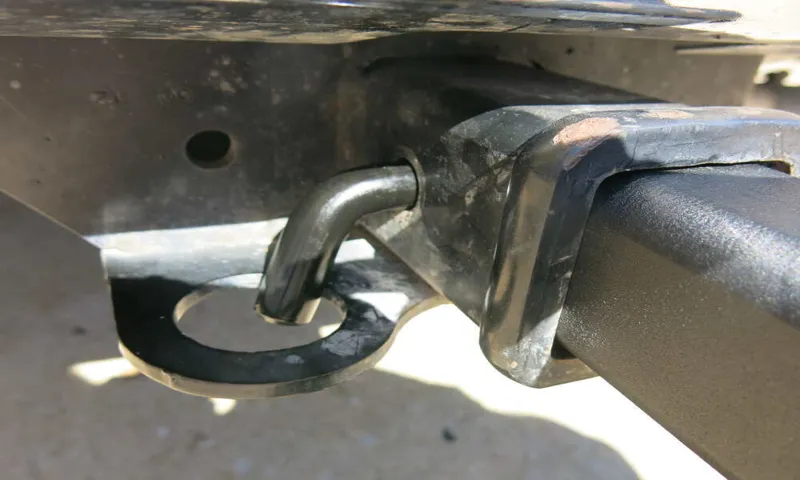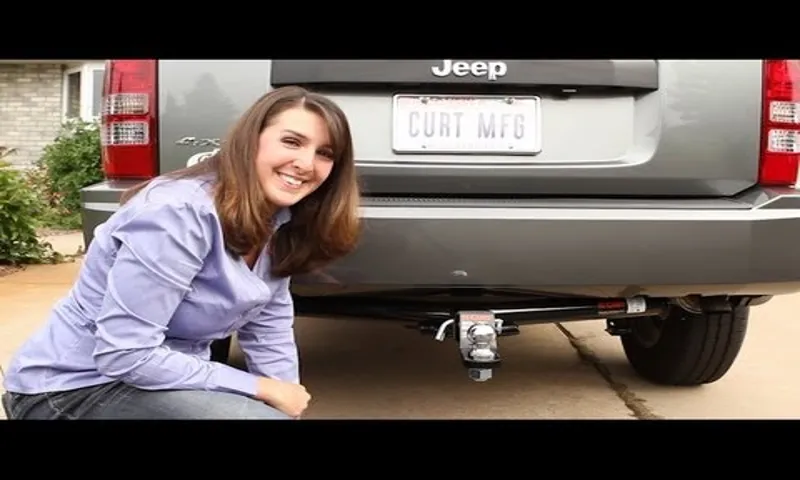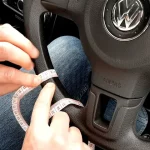Hitch pins are fundamental components when it comes to towing. These small, yet essential pieces of hardware ensure that your trailer is securely attached to your towing vehicle. Without a hitch pin, your trailer could detach from your vehicle and cause an accident on the road.
However, if you’re a newbie in towing, using a hitch pin might be a daunting task. How do you use it? Where do you position it? Don’t worry! This guide will provide you with all the information you need to use a hitch pin safely and effectively. From selecting the right size to attaching it to your hitch, we’ve got you covered! So, let’s dive into the details!
Table of Contents
What is a Hitch Pin?
Hitch pins are small but mighty tools that are incredibly helpful when you need to attach two objects together. They consist of a pin, typically made of steel or hardened steel, and a clip that secures the pin in place. If you’re wondering how to use a hitch pin, the process is fairly straightforward.
First, insert the pin through the hole in one object and make sure it extends fully through the other side. Then, place the clip over the end of the pin to prevent it from slipping out of place. Hitch pins are commonly used for connecting trailers to vehicles, but can also be used for a variety of other applications, such as securing equipment or holding doors shut.
It’s important to choose the right size hitch pin for the job to ensure a secure fit. So, next time you need to connect two objects, reach for a hitch pin – they make the job much easier!
Definition of a Hitch Pin
A hitch pin is a simple yet essential component used to secure different hitch components in place. Hitch pins are commonly used with trailer hitches, but they are also used to connect other towing equipment. A hitch pin works by holding the hitch ball mount securely on the trailer hitch receiver, which helps in keeping the trailer hitched to the vehicle.
They come in different sizes and styles and can be made from various materials, including steel, stainless steel, and aluminum. Using the right-size hitch pin is vital in preventing accidental detachments of the trailer from the tow vehicle. The size of the hitch pin is based on the diameter of the hole in the receiver and the thickness of the hitch component being secured.
A hitch pin that is too small for the hitch component may not stay in place and risk the hitch component moving around. On the other hand, a hitch pin that is too big for the receiver may damage the hitch component or even the receiver itself. In summary, a hitch pin is an essential tool that helps secure the hitch components in place and ensures the safety of both the vehicle and the trailer.
It is important to choose the right size and type of hitch pin for the particular towing situation, and always inspect the hitch pin and other components regularly for signs of wear and tear.

Types of Hitch Pins
A hitch pin is a simple yet essential component for trailers and towing vehicles. It’s a metal pin that locks into place to secure the hitch, preventing it from falling off during transportation. There are several types of hitch pins available in the market, each designed to fit specific hitch types.
Firstly, there’s the standard hitch pin, suitable for most hitch types with a 5/8-inch diameter pin. Next, we have the hairpin-style hitch pin, which has a thin wire loop that locks the pin in place. It’s easy to install and remove, making it ideal for quick hitch changes.
Another type is the quick-release hitch pin, which comprises a push-button release mechanism that allows you to quickly attach and remove the hitch. Additionally, there’s the fifth-wheel kingpin lock, specially designed to secure fifth-wheel hitches in place. With these varying types of hitch pins, it’s essential to choose the right one for your trailer or towing vehicle to ensure safety, easy installation, and a secure hold.
Step-by-Step Guide to using a Hitch Pin
If you’re new to towing, a hitch pin might seem like a confusing accessory. However, it’s a crucial component of your towing setup that ensures your cargo stays securely attached to your vehicle. Using a hitch pin is a fairly simple process.
First, you’ll want to insert the pin through the hole in your hitch receiver and make sure it’s completely through. Then, secure the pin by sliding a clip through the pin’s hole. Make sure the clip is snug and tight, as a loose clip could cause the pin to fall out while you’re driving.
With the hitch pin in place, your towing setup is now secure and ready to hit the road. Remember to check your hitch pin periodically throughout your trip for any potential loosening. Overall, using a hitch pin is a straightforward process that can prevent disastrous situations on the road.
Step 1: Align the hole with the hitch pin
Using a hitch pin may seem like a daunting task for beginners, but it’s actually quite simple with the proper steps. Step one involves aligning the hole on the hitch with the hitch pin. This may seem obvious, but it’s essential to ensure that the pin will be inserted correctly.
It’s important to note that some hitch pins may have multiple holes, so make sure to use the correct one. Once the hole is aligned, insert the hitch pin, and make sure it’s securely in place. A loose hitch pin can be dangerous and may cause damage to both the vehicle and what’s being towed.
It’s always a good idea to double-check that the pin is secure before hitting the road. With these simple steps, using a hitch pin will become second nature in no time.
Step 2: Insert the hitch pin into the hole
Using a hitch pin may seem like a simple task, but it’s important to do it properly for safety and security. Step two involves inserting the hitch pin through the hole in the hitch receiver and trailer or accessory being towed. When choosing a hitch pin, make sure it fits the size of the hitch receiver and the diameter of the hole.
Once you have the proper size, line up the holes and push the pin through. It should click into place and be secure. If it’s loose or doesn’t click, try pushing it in further or adjusting the alignment.
Always check that the hitch pin is properly inserted before towing to prevent accidents or damage to your vehicle or trailer. Double-checking can save you time and headaches down the road.
Step 3: Secure the hitch pin with a clip or lock
Using a hitch pin to secure your trailer hitch is a quick and simple process, but it’s crucial to ensure that you do it correctly. After inserting the pin into the hole in the receiver tube, the next step is to secure it with either a clip or a lock. This helps keep the pin in place and prevents your hitch ball from falling off while you’re driving.
A clip is the most common and simple option, although it does not offer as much security as a lock. A lock, on the other hand, requires a key to remove and is more difficult for potential thieves to tamper with. It’s important to note that different types of hitch pins require specific types of clips or locks, so be sure to check the manufacturer’s instructions before selecting one.
By taking the time to properly secure your hitch pin, you can have peace of mind knowing that your trailer is safely connected to your vehicle.
Tips for Using a Hitch Pin Safely
If you’re planning to tow a trailer, it’s important to use a hitch pin to secure the trailer to your vehicle safely and securely. Here are a few tips for using a hitch pin effectively: First, make sure you purchase the right-sized hitch pin for your vehicle and trailer. The pin should fit snugly into the receiver tube and through the hole in the hitch ball.
Next, inspect the hitch pin and receiver tube before each use to ensure they are free of rust, corrosion, or damage. Replace any damaged parts before towing. When you are ready to use the hitch pin, slide it through the hole in the hitch ball and secure it with a clip or locking mechanism.
Be sure to follow the manufacturer’s instructions for securing the pin, and double-check that it is secure before hitting the road. During towing, periodically stop and check the hitch pin and receiver tube to ensure they remain securely in place. If you notice any movement or looseness, stop and re-secure the hitch pin.
Finally, when you arrive at your destination and are ready to detach the trailer, be sure to remove the hitch pin carefully. Use a gloved hand to prevent injury, and be aware of the possibility of the pin springing out unexpectedly. By following these tips and taking care to use a hitch pin safely, you can ensure a smooth and secure towing experience.
Always check the weight rating of the hitch pin
When it comes to safely towing trailers, using a hitch pin is crucial. These small yet mighty pins keep your trailer connected to your vehicle, but it’s important to remember that not all hitch pins are created equal. Before you start towing, always check the weight rating of the hitch pin you’re using.
Using a pin that can’t handle the weight of your trailer is a recipe for disaster. It’s also important to double-check that the pin is fully inserted and secured before hitting the road. Another tip for using a hitch pin safely is to regularly inspect it for signs of wear and tear.
If you notice any cracks, bending, or rust, it’s time to replace the pin. By following these simple tips, you’ll be well on your way to a safe and successful towing experience.
Replace a damaged or worn hitch pin immediately
When it comes to towing, using a hitch pin is essential for securing the towed load. However, it’s crucial to use this equipment safely to avoid any accidents or issues. One important tip for using a hitch pin safely is to replace a damaged or worn pin immediately.
The hitch pin is responsible for keeping the hitch ball in place, so any damage to it could compromise the security of the towed load. It’s recommended to inspect the pin before each use and look for signs of wear or damage, such as rust or cracks. If you notice any issues, it’s best to replace the pin right away to prevent any unforeseen problems on the road.
By implementing this tip, you’ll be taking a significant step towards safer towing.
Conclusion
In the wise words of Hitch, ‘Life is not the amount of breaths you take, it’s the moments that take your breath away.’ And while we can’t guarantee that your hitch pin installation will take your breath away, we can promise it will bring ease and functionality to your towing experience. So, whether you’re hauling a boat, an ATV, or a load of rocks for your garden project, remember the simple steps to using a hitch pin and make your towing adventures Hitch-approved!”
FAQs
What is a hitch pin?
A hitch pin is a fastener that is used to secure a trailer hitch to a towing vehicle.
How do you use a hitch pin?
To use a hitch pin, insert the pin into the hole in the hitch receiver and through the hole in the ball mount or accessory, then secure it using the cotter pin or lock.
What size hitch pin do I need?
The size of the hitch pin you need depends on the size of your hitch receiver and ball mount or accessory. Check the manufacturer’s recommendations for the correct size.
Can I use any type of hitch pin?
No, you should use a hitch pin that is specifically designed for your hitch receiver and ball mount or accessory.
Can a hitch pin be reused?
Yes, a hitch pin can be reused as long as it is in good condition and not worn or damaged.
What is the difference between a hitch pin and a hitch lock?
A hitch pin is a basic fastener that secures a trailer hitch, while a hitch lock provides added security by preventing unauthorized removal of the hitch.
How do I know if my hitch pin is secure?
To make sure your hitch pin is secure, check that it is inserted correctly and all the way through the hitch receiver and ball mount or accessory, and that the cotter pin or lock is properly secured.



